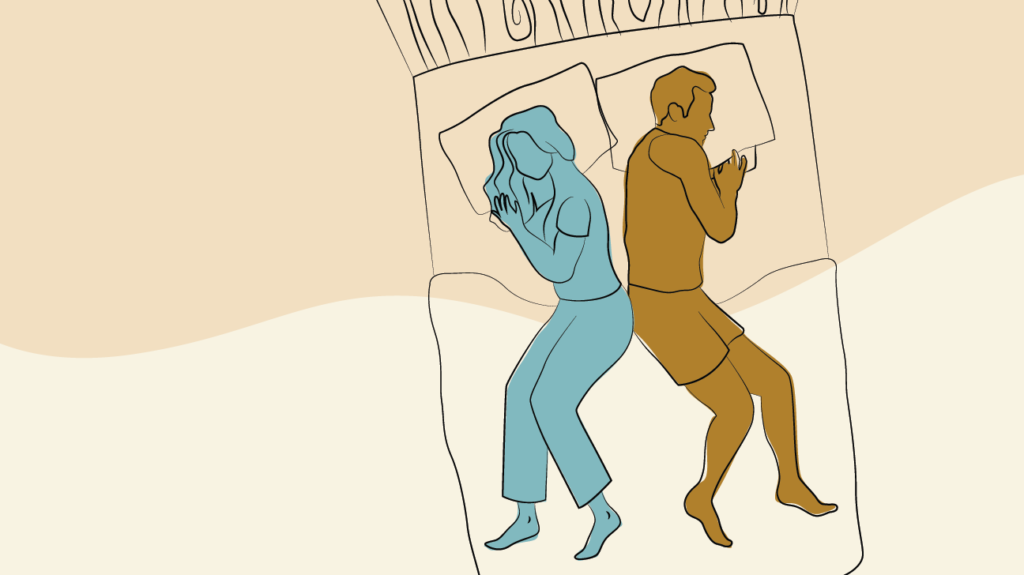The Best Sleeping Positions for Couples: How to Enhance Your Intimacy and Sleep Quality

Understanding the Importance of Sleeping Positions for Couples

The sleeping position you choose as a couple can have a significant impact on your overall health and well-being. While it may seem like a trivial matter, the position in which you and your partner sleep can affect your intimacy, communication, and even your quality of sleep. Understanding the importance of finding the right sleeping position for couples can help foster a stronger connection and improve your overall sleep quality.
Sleeping positions can either enhance or hinder intimacy between partners. For instance, the classic and intimate spooning position, where one partner embraces the other from behind, promotes a sense of closeness and security. This position allows for physical contact and provides emotional comfort, allowing couples to feel connected even as they sleep. Conversely, sleeping in positions that lack physical touch, such as sleeping back-to-back, may create a sense of distance and detachment, impacting the emotional bond between partners. By understanding the impact of different sleeping positions, couples can choose positions that enhance their intimacy and strengthen their connection.
The Benefits of Sharing a Bed with Your Partner

Sharing a bed with your partner can have numerous benefits, both for your physical and emotional well-being. One of the key advantages is the potential for increased intimacy. Being in close proximity to your partner during sleep allows for a deeper connection and a sense of comfort. The physical touch that occurs while sharing a bed can release oxytocin, often referred to as the “love hormone,” which promotes feelings of closeness and bonding.
Another benefit of sharing a bed is the potential for better sleep quality. Research has shown that individuals who sleep next to their partner tend to experience fewer sleep disturbances compared to those who sleep alone. This can be attributed to the feeling of security and safety that comes with having a loved one nearby. The presence of a partner can also provide a sense of emotional support, reducing stress levels and promoting relaxation.
Furthermore, sharing a bed can enhance communication and strengthen the emotional connection in a relationship. Spending time together before falling asleep and upon waking up can provide opportunities for open and honest conversations. This can foster a deeper understanding of each other’s needs and desires, leading to improved overall relationship satisfaction.
While sharing a bed can have many benefits, it is important to acknowledge that individual sleep preferences and conditions may vary. It is crucial to find a sleeping position that accommodates both partners’ comfort and sleep quality. Taking into consideration factors such as snoring, restless leg syndrome, or body temperature differences can help optimize the sleep experience for both individuals.
Factors to Consider When Choosing the Right Sleeping Position
Choosing the right sleeping position is crucial for couples to ensure a comfortable and restful night’s sleep. When considering the best position, it is important to take into account individual preferences, personal comfort levels, and any physical limitations or health issues. Understanding these factors will not only lead to better sleep quality but also contribute to a harmonious relationship between partners.
One factor to consider when choosing a sleeping position is any existing health conditions or physical limitations. For instance, individuals with back pain or spinal issues may find it more comfortable to sleep in positions that promote proper alignment and support. Pregnant women may benefit from sleeping on their side to improve blood flow and reduce pressure on the abdomen. Similarly, individuals with sleep apnea or snoring problems may find relief by sleeping in positions that minimize airway obstruction. By considering these factors, couples can choose a sleeping position that promotes better health and overall well-being.
Another factor to consider is individual comfort and personal preference. Each person has their own unique sleeping habits and comfort levels. Some individuals may find it easier to fall asleep and stay asleep in certain positions, while others prefer more freedom of movement during the night. It is important for couples to communicate and understand each other’s preferences to ensure a mutually satisfying sleeping experience. Finding a compromise that meets both partners’ needs can contribute to a more peaceful and restorative sleep.
Research has shown certain positions can be healthier than others, while some have been found to reduce snoring and improve digestion.
Position 1: Spooning – The Classic and Intimate Sleeping Position

The spooning sleeping position is widely recognized as a classic and intimate way for couples to sleep together. In this position, one partner typically takes a protective stance, curling their body behind their partner’s and fitting together like spoons. This close physical contact creates a sense of security and emotional intimacy, fostering a deeper connection between partners.
From a physiological perspective, spooning can have several benefits for both partners. It promotes the release of oxytocin, often referred to as the “love hormone,” which can enhance feelings of attachment and affection. Additionally, the physical contact and warmth shared in this position can help regulate body temperature and promote feelings of comfort and relaxation, leading to a more restful night’s sleep. However, it’s important to note that the spooning position may not be suitable for everyone, as individual preferences and physical comfort levels can vary.
Position 2: The Hugging Position – Deepening Connection and Comfort

The hugging position, also known as the spooning position, is a popular and intimate sleeping position among couples. In this position, one partner, typically the bigger spoon, wraps their arms around the other, creating a sense of comfort and security. This physical contact releases oxytocin, also known as the “love hormone,” which deepens the emotional connection between partners.
Not only does the hugging position promote emotional closeness, but it also enhances physical comfort during sleep. The closeness of bodies provides warmth and support, which can help reduce stress and anxiety, allowing both partners to enjoy a more restful sleep. The hugging position also aligns the bodies in a way that can alleviate aches and pains, especially in the lower back. Couples who choose this position often appreciate the feeling of being physically connected, even while they’re deep in slumber.
Position 3: The Face-to-Face Position – Enhancing Intimacy and Communication

The face-to-face sleeping position, also known as the “spooning with eye contact” position, is characterized by both partners lying on their sides facing each other. This position allows for maximum physical closeness and enhances intimacy and communication between couples. When you and your partner sleep face-to-face, you can enjoy the comfort of feeling each other’s body warmth and the reassuring physical presence. This can promote a sense of security and emotional connection, which can be especially beneficial for couples who are looking to deepen their bond.
In addition to the emotional benefits, the face-to-face position also facilitates communication between partners. With your bodies facing each other, it becomes easier to engage in intimate conversations before drifting off to sleep or upon waking up. This can be a time to share thoughts, concerns, dreams, or simply enjoy quiet moments of connection. The face-to-face position allows for eye contact, which can further strengthen the emotional and physical connection between you and your partner. This eye contact can create a sense of intimacy and trust, helping to build deeper emotional ties within the relationship. Overall, the face-to-face sleeping position offers couples an opportunity to enhance both physical and emotional intimacy, fostering a stronger connection and communication in their relationship.
Position 4: The Back-to-Back Position – Maintaining Independence and Comfort

When it comes to sharing a bed with your partner, finding a sleeping position that allows for both independence and comfort is essential. One popular option for couples is the back-to-back position. In this position, both partners are facing away from each other, with their backs touching. This position provides a sense of physical separation while still maintaining a connection through touch.
For those who value their personal space, the back-to-back position offers a sense of independence and freedom of movement during sleep. It allows each partner to have their own side of the bed and create a physical barrier that promotes a sense of privacy. This can be particularly important for individuals who are light sleepers or easily disturbed by their partner’s movements during the night. The back-to-back position also allows for optimal airflow and reduces the chances of overheating, as there is more space between the bodies. Overall, this position provides a balance between maintaining personal space and physical contact, promoting both independence and comfort during sleep.
Position 5: The Starfish Position – Finding Space and Solace
Position 5: The Starfish Position, also known as the “spread eagle,” provides couples with the opportunity to find personal space and solace while still sharing a bed. In this position, one partner stretches out and takes up a larger portion of the bed, while the other partner may choose to cuddle or maintain their own sleeping space. This position can be beneficial for couples who value their independence and desire a sense of personal space during sleep.
Sleeping in the Starfish Position offers several advantages. Firstly, it allows individuals to spread out and find a comfortable position that supports their body’s unique needs. This can be especially beneficial for couples who have different sleeping preferences, such as one partner who prefers a softer mattress and the other who prefers a firmer one. Moreover, the extended space in this position can result in reduced disturbance from movement during the night, making it easier for both partners to achieve a restful sleep. Lastly, the Starfish Position can provide individuals with a sense of emotional solace, as having personal space during sleep can contribute to feelings of relaxation and freedom.
The Starfish Position may not be suitable for all couples, as it can lead to a physical distance between partners and potentially limit physical contact during sleep. For those who prioritize physical closeness and intimacy, this position may not fully meet their needs. Additionally, individuals with certain medical conditions, such as snoring or sleep apnea, may find that this position exacerbates their symptoms. It is important for couples to communicate and find a compromise that allows for both individual comfort and emotional connection.
Position 6: The Tangle Position – Embracing Intimacy and Playfulness
The Tangle Position, also known as the Twister or the Knot, is a sleeping position that exudes intimacy and playfulness between couples. In this position, both partners intertwine their bodies, often with their legs intertwined and their arms wrapped around each other. This position is a favorite among couples who value physical closeness and enjoy the feeling of being entangled with their partner.
Sleeping in the Tangle Position can have several benefits for both partners. Firstly, it allows for increased skin-to-skin contact, which stimulates the release of oxytocin, also known as the “love hormone.” Oxytocin is associated with feelings of bonding, trust, and affection, making the Tangle Position a great choice for couples looking to deepen their emotional connection. Additionally, the physical closeness can promote feelings of security and comfort, leading to a more restful night’s sleep for both partners.
While the Tangle Position can be incredibly intimate, it may not be suitable for everyone. Couples who prefer a bit more personal space while sleeping may find the close proximity uncomfortable. Additionally, those who tend to sleep hot or have restricted mobility may also struggle with this position. It’s important for couples to communicate and find a balance between their individual needs and desires for intimacy in order to choose the right sleeping position for them.
Position 7: The Pillow Barrier – Addressing Different Comfort Needs
The Pillow Barrier sleeping position is a popular choice for couples who have different comfort needs during sleep. This position involves placing a pillow barrier between partners to create a physical boundary that allows each individual to have their own space and sleep in a way that is most comfortable for them. The use of pillows as a barrier helps address issues such as varied body temperatures, different sleep preferences, and even reducing the likelihood of disturbances caused by movements during the night.
One of the main benefits of the Pillow Barrier position is that it allows each partner to have control over their own sleep environment. This can be particularly useful when one person prefers a firmer mattress or likes to sleep with an extra pillow, while the other may prefer a softer surface or fewer pillows. By having their own sleeping space, couples can avoid arguments or compromises regarding the mattress and bedding, thus promoting a better sleep experience for both individuals. Additionally, the Pillow Barrier position can help reduce disruptions caused by a restless sleeper, as the physical barrier provides a sense of separation that minimizes the transfer of motion between partners.
Position 8: The Separate Beds Option – Finding Balance and Sleep Quality
The Separate Beds option is one that has gained popularity in recent years, as couples seek to find a balance between their individual sleep needs and quality rest. While it may initially seem counterintuitive to sleep in separate beds when in a committed relationship, there are certain situations where it may be the best option for both partners.
One common reason for choosing separate beds is when one partner has different sleep preferences or needs. For example, if one partner snores loudly or has restless leg syndrome, it can significantly disrupt the other person’s sleep. By sleeping in separate beds, both partners can ensure they get the uninterrupted rest they need, which in turn contributes to better physical and mental well-being. Additionally, if one partner works night shifts or has a different sleep schedule, being able to sleep in separate beds can help maintain a healthy sleep routine for both individuals.
Tips for Improving Sleep Quality as a Couple
Sleep is an essential element for overall well-being and maintaining a healthy relationship. When it comes to improving sleep quality as a couple, there are several tips that can be beneficial. Firstly, creating a comfortable sleep environment is crucial. This includes investing in a quality mattress and pillows that provide adequate support for both partners. Additionally, ensuring that the bedroom is dark, quiet, and at a comfortable temperature can promote better sleep.
Establishing a consistent bedtime routine can also contribute to improved sleep quality. This could involve engaging in relaxation techniques such as deep breathing exercises or gentle stretching before bed. It is important to avoid stimulating activities, such as using electronic devices, close to bedtime as the blue light emitted can disrupt sleep patterns. Creating a calm and tranquil atmosphere in the evening can help signal to the body that it is time to wind down and prepare for sleep. By implementing these strategies, couples can enhance their sleep quality and reap the benefits of a well-rested relationship.
Here’s a table summarizing tips for improving sleep quality as a couple and their associated benefits:
| Tips for Improving Sleep Quality as a Couple | Benefits and Considerations | Credible Source |
|---|---|---|
| Establish a Consistent Sleep Schedule | Having a regular sleep schedule helps regulate circadian rhythms, aligning both partners’ internal clocks for better sleep quality. | National Sleep Foundation – How to Sleep Better |
| Create a Comfortable Sleep Environment | A comfortable bedroom with a suitable mattress and pillows promotes relaxation, contributing to better sleep for both partners. | Mayo Clinic – How to choose a mattress |
| Limit Screen Time Before Bed | Avoiding screens before bedtime reduces exposure to blue light, promoting melatonin production and improving the quality of sleep for both partners. | Harvard Health Publishing – Blue light has a dark side |
| Communicate about Sleep Preferences | Open communication about individual sleep preferences, such as room temperature or noise levels, helps create an environment conducive to restful sleep for both partners. | Sleep Medicine Reviews – Sleep-related couple interactions: A novel approach to the conceptualization and measurement of couple sleep |
| Invest in a Larger Bed if Needed | Having enough space in bed can prevent disturbances and disruptions during sleep, allowing both partners to move comfortably without affecting each other’s rest. | Sleep.org – Bed Size Chart: Which Bed Size is Right for You? |
| Address Snoring and Sleep Apnea | Seeking treatment for snoring or sleep apnea improves sleep quality for both partners, ensuring uninterrupted rest and reducing potential health risks. | American Academy of Sleep Medicine – Snoring and Sleep Apnea |
| Practice Relaxation Techniques | Incorporating relaxation techniques, such as deep breathing or meditation, before bedtime can help both partners unwind and promote a calm atmosphere for sleep. | National Sleep Foundation – Relaxation Exercises for Better Sleep |
| Prioritize Physical Activity | Regular physical activity contributes to overall well-being and can enhance sleep quality. Engaging in exercise together can be a shared, healthy routine. | Mayo Clinic – Exercise and Sleep: The Surprising Connection |
Conclusion: Discovering the Perfect Sleeping Position for You and Your Partner
In conclusion, discovering the perfect sleeping position for you and your partner is crucial for maintaining a healthy and harmonious relationship. By understanding the different positions available and considering factors such as intimacy, communication, comfort, and individual preferences, you can find a sleeping position that suits both of you.
It is important to keep in mind that there is no one-size-fits-all solution when it comes to sleeping positions for couples. What works for one couple may not work for another. Experimenting with different positions and being open to communication and compromise will help you find the ideal sleep arrangement that enhances your overall sleep quality and relationship satisfaction.
How important are sleeping positions for couples?
Sleeping positions for couples are important as they can affect the quality of sleep and overall comfort for both individuals. Finding the right position can lead to better sleep and promote intimacy in relationships.
What are the benefits of sharing a bed with your partner?
Sharing a bed with your partner can promote a sense of closeness and connection. It can also improve communication and intimacy, leading to a stronger bond between partners. Additionally, sharing a bed can provide emotional support and comfort.
What factors should be considered when choosing the right sleeping position?
When choosing a sleeping position, consider factors such as personal comfort, sleep preferences, physical health conditions, and any issues with snoring or sleep disturbances. It’s important to find a position that suits both partners’ needs and promotes optimal sleep quality.
What is the “Spooning” sleeping position?
The spooning position is a classic and intimate sleeping position where one partner lies on their side, with their back against the other partner’s front. This position promotes physical closeness and can create a sense of security and comfort.
What is the “Hugging” sleeping position?
The hugging position is a sleeping position where both partners lie on their sides, facing each other, with their arms wrapped around each other. This position deepens the connection between partners and provides a sense of comfort and warmth.
What is the “Face-to-Face” sleeping position?
The face-to-face position involves both partners lying on their sides, facing each other. This position enhances intimacy and allows for increased communication and eye contact between partners during sleep.
What is the “Back-to-Back” sleeping position?
The back-to-back position is when both partners sleep on their sides, with their backs touching. This position allows for independence and personal space while still maintaining physical contact with your partner.
What is the “Starfish” sleeping position?
The starfish position is when one partner sprawls out on the bed, taking up a significant amount of space, while the other partner sleeps in a separate position. This position allows for finding individual space and comfort during sleep.
What is the “Tangle” sleeping position?
The tangle position involves partners intertwining their legs and bodies while sleeping. This position promotes intimacy, playfulness, and a sense of being physically connected throughout the night.
How can the “Pillow Barrier” sleeping position address different comfort needs?
The pillow barrier position involves placing a pillow between partners to create a physical barrier while still maintaining proximity. This position allows partners to have their own space and addresses different comfort needs such as temperature preferences or differing sleep positions.
What is the “Separate Beds” option for couples?
The separate beds option refers to couples choosing to sleep in separate beds within the same bedroom or even in separate bedrooms. This option can help couples find a balance between individual sleep needs and preferences while still maintaining closeness and intimacy.
What are some tips for improving sleep quality as a couple?
Some tips for improving sleep quality as a couple include investing in a larger bed if space allows, using supportive pillows and mattresses, establishing a consistent bedtime routine, keeping the bedroom cool, dark, and quiet, and addressing any sleep disorders or issues with snoring.
How can couples discover the perfect sleeping position for them?
Couples can discover the perfect sleeping position by openly discussing and experimenting with different positions that suit their individual and collective needs. It may require some trial and error, but finding a position that promotes comfort, intimacy, and quality sleep for both partners is key.






